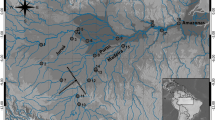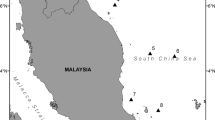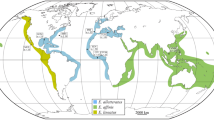Abstract
Marine fish generally show higher genetic diversity and shallower population structure than freshwater fish, but data for rare species are lacking. A latid fish, akame (Lates japonicus), is a rare, large predatory fish endemic to Japan, occurring mainly in the estuaries and coastal waters of Kochi and Miyazaki prefectures. Among species of Lates, akame is the only one adapted to temperate waters, while the others are distributed in tropical waters. Despite conservation concerns for this species, almost nothing is known about its population genetic characteristics. We used amplified fragment length polymorphism (AFLP) and mitochondrial DNA (mtDNA) markers to describe the genetic variation and its partitioning among juvenile samples collected from multiple localities and over different years. Twenty-four primer combinations detected a total of 522 AFLP loci, only 40 (7.7 %) of which were polymorphic. Sequence analysis of the entire mtDNA control region identified only five haplotypes defined by four variable sites. The level of genetic diversity revealed by both genetic markers was unusually low compared to other marine fish and comparable to levels observed for some endangered freshwater fish exhibiting some of the lowest levels of genetic diversity among vertebrate populations. Analysis of molecular variance for the AFLP data indicated a weak but significant population structure (F CT = 0.07, P < 0.001) between the Kochi and Miyazaki regions. Our results highlight the need for in situ conservation efforts for akame across its entire distribution range and throughout its entire life cycle to minimize extinction risks associated with environmental and demographic stochasticity.



Similar content being viewed by others
References
Avise JC (2000) Phylogeography: the history and formation of species. Harvard University Press, Cambridge
Bensch S, Åkesson M (2005) Ten years of AFLP in ecology and evolution: why so few animals? Mol Ecol 14:2899–2914. doi:10.1111/j.1365-294X.2005.02655.x
Bouckaert RR (2010) DensiTree: making sense of sets of phylogenetic trees. Bioinformatics 26:1372–1373. doi:10.1093/bioinformatics/btq110
Bryant D, Bouckaert R, Felsenstein J, Rosenberg NA, RoyChoudhury A (2012) Inferring species trees directly from biallelic genetic markers: bypassing gene trees in a full coalescent analysis. Mol Biol Evol 29:1917–1932. doi:10.1093/molbev/mss086
Campbell D, Bernatchez L (2004) Generic scan using AFLP markers as a means to assess the role of directional selection in the divergence of sympatric whitefish ecotypes. Mol Biol Evol 21:945–956. doi:10.1093/molbev/msh101
Chenoweth SF, Hughes JM, Keenan CP, Lavery S (1998a) Concordance between dispersal and mitochondrial gene flow: isolation by distance in a tropical teleost, Lates calcarifer (Australian barramundi). Heredity 80:187–197
Chenoweth SF, Hughes JM, Keenan CP, Lavery S (1998b) When oceans meet: a teleost shows secondary intergradation at an Indian–Pacific interface. Proc R Soc Lond B 265:415–420. doi:10.1098/rspb.1998.0310
DeWoody JA, Avise JC (2000) Microsatellite variation in marine, freshwater and anadromous fishes compared with other animals. J Fish Biol 56:461–473. doi:10.1111/j.1095-8649.2000.tb00748.x
Earl DA, vonHoldt BM (2012) STRUCTURE HARVESTER: a website and program for visualizing STRUCTURE output and implementing the Evanno method. Conserv Genet Resour 4:359–361. doi:10.1007/s12686-011-9548-7
Evanno G, Regnaut S, Goudet J (2005) Detecting the number of clusters of individuals using the software STRUCTURE: a simulation study. Mol Ecol 14:2611–2620
Excoffier L, Lischer HEL (2010) Arlequin suite ver 3.5: a new series of programs to perform population genetics analyses under Linux and Windows. Mol Ecol Resour 10:564–567. doi:10.1111/j.1755-0998.2010.02847.x
Excoffier L, Smouse PE, Quattro JM (1992) Analysis of molecular variance inferred from metric distances among DNA haplotypes: application to human mitochondrial DNA restriction data. Genetics 131:479–491
Falush D, Stephens M, Pritchard JK (2007) Inference of population structure using multilocus genotype data: dominant markers and null alleles. Mol Ecol Notes 7:574–578
Flower BP, Kennett JP (1994) The middle Miocene climatic transition: East Antarctic ice sheet development, deep ocean circulation and global carbon cycling. Palaeogeogr Palaeoclimatol Palaeoecol 108:537–555
Foose TJ (1986) Riders of the last ark: the role of captive breeding in conservation strategies. In: Kaufman L, Mallory K (eds) The last extinction. MIT Press, Cambridge, pp 149–178
Frankham R, Ballou JD, Briscoe DA (2010) Introduction to conservation genetics, 2nd edn. Cambridge University Press, Cambridge
Frost LA, Evans BS, Jerry DR (2006) Loss of genetic diversity due to hatchery culture practices in barramundi (Lates calcarifer). Aquaculture 261:1056–1064. doi:10.1016/j.aquaculture.2006.09.004
Garoia F, Guarniero I, Grifoni D, Marzola S, Tinti F (2007) Comparative analysis of AFLPs and SSRs efficiency in resolving population genetic structure of Mediterranean Solea vulgaris. Mol Ecol 16:1377–1387. doi:10.1111/j.1365-294X.2007.03247.x
Greenwood PH (1976) A review of the family Centropomidae (Pisces, Perciformes). Bull Brit Mus Nat Hist Zool 29:1–81
Innan H, Terauchi R, Kahl G, Tajima F (1999) A method for estimating nucleotide diversity from AFLP data. Genetics 151:1157–1164
Iwatsuki Y, Tashiro K, Hamasaki T (1993) Distribution and fluctuation in occurrence of the Japanese centropomid fish, Lates japonicus. Jpn J Ichthyol 40:327–332
Japan Ministry of the Environment (2013) Threatened wildlife of Japan, red data book, 4th edn. Japan Wildlife Research Center, Tokyo (in Japanese)
Johnson JA, Tingay RE, Culver M, Hailer F, Clarke ML, Mindell DP (2009) Long-term survival despite low genetic diversity in the critically endangered Madagascar fish-eagle. Mol Ecol 18:54–63. doi:10.1111/j.1365-294X.2008.04012.x
Kakehi Y, Nakayama K, Watanabe K, Nishida M (2005) Inheritance of amplified fragment length polymorphism markers and their utility in population genetic analysis of Plecoglossus altivelis. J Fish Biol 66:1529–1544. doi:10.1111/j.1095-8649.2005.00683.x
Katayama M, Taki Y (1984) Lates japonicus, a new centropomid fish from Japan. Jpn J Ichthyol 30:361–367
Kinoshita I, Iwatsuki Y (1996) Akame Lates japonicus. In: Japanese Society for the Protection of Fishery Resources (ed) Basic data on rare aquatic wildlife of Japan (III). Japanese Society for the Protection of Fishery Resources, Tokyo, pp 103–106 (in Japanese)
Kinoshita I, Fujita S, Takahashi I, Azuma K (1988) Occurrence of larval and juvenile Japanese snook, Lates japonicus, in the Shimanto estuary, Japan. Jpn J Ichthyol 34:462–467
Kubota H, Watanabe K, Kakehi Y, Watanabe S (2008) An assessment of genetic diversity in wild and captive populations of endangered Japanese bitterling Tanakia tanago (Cyprinidae) using amplified fragment length polymorphism (AFLP) markers. Fish Sci 74:494–502
Lin G, Lo LC, Zhu ZY, Feng F, Chou R, Yue GH (2006) The complete mitochondrial genome sequence and characterization of single-nucleotide polymorphisms in the control region of the Asian seabass (Lates calcarifer). Mar Biotechnol 8:71–79. doi:10.1007/s10126-005-5051-z
Luikart G, Sherwin WB, Steele BM, Allendorf FW (1998) Usefulness of molecular markers for detecting population bottlenecks via monitoring genetic change. Mol Ecol 7:963–974. doi:10.1046/j.1365-294x.1998.00414.x
Lynch M, Milligan BG (1994) Analysis of population genetic structure with RAPD markers. Mol Ecol 3:91–99. doi:10.1111/j.1365-294X.1994.tb00109.x
Mabuchi K, Miya M, Azuma Y, Nishida M (2007) Independent evolution of the specialized pharyngeal jaw apparatus in cichlid and labrid fishes. BMC Evol Biol 7:10. doi:10.1186/1471-2148-7-10
McCusker MR, Bentzen P (2010a) Historical influences dominate the population genetic structure of a sedentary marine fish, Atlantic wolffish (Anarhichas lupus), across the North Atlantic Ocean. Mol Ecol 19:4228–4241. doi:10.1111/j.1365-294X.2010.04806.x
McCusker MR, Bentzen P (2010b) Positive relationships between genetic diversity and abundance in fishes. Mol Ecol 19:4852–4862. doi:10.1111/j.1365-294X.2010.04822.x
Milot E, Weimerskirch H, Duchesne P, Bernatchez L (2007) Surviving with low genetic diversity: the case of Albatrosses. Proc R Soc B Biol Sci 274:779–787. doi:10.1098/rspb.2006.0221
Miya M, Friedman M, Satoh TP, Takeshima H, Sado T, Iwasaki W, Yamanoue Y, Nakatani M, Mabuchi K, Inoue JG, Poulsen JY, Fukunaga T, Sato Y, Nishida M (2013) Evolutionary origin of the Scombridae (tunas and mackerels): members of a paleogene adaptive radiation with 14 other pelagic fish families. PLoS ONE 8:e73535. doi:10.1371/journal.pone.0073535
Mock KE, Evans RP, Crawford M, Cardall BL, Janecke SU, Miller MP (2006) Rangewide molecular structuring in the Utah sucker (Catostomus ardens). Mol Ecol 15:2223–2238. doi:10.1111/j.1365-294X.2006.02932.x
Moritz C (1999) Conservation units and translocations: strategies for conserving evolutionary processes. Hereditas 130:217–228. doi:10.1111/j.1601-5223.1999.00217.x
Nei M, Li WH (1979) Mathematical model for studying genetic variation in terms of restriction endonucleases. Proc Natl Acad Sci USA 76:5269–5273
O’Leary SJ, Hice LA, Feldheim KA, Frisk MG, McElroy AE, Fast MD, Chapman DD (2013) Severe inbreeding and small effective number of breeders in a formerly abundant marine fish. PLoS ONE 8:e66126. doi:10.1371/journal.pone.0066126
Pinsky ML, Palumbi SR (2014) Meta-analysis reveals lower genetic diversity in overfished populations. Mol Ecol 23:29–39. doi:10.1111/mec.12509
Pompanon F, Bonin A, Bellemain E, Taberlet P (2005) Genotyping errors: causes, consequences and solutions. Nat Rev Genet 6:847–859. doi:10.1038/nrg1707
Pritchard JK, Stephens M, Donnelly P (2000) Inference of population structure using multilocus genotype data. Genetics 155:945–959
Rambaut A, Drummond AJ (2007) Tracer v1.4. http://beast.bio.ed.ac.uk/software/tracer/
Rice WR (1989) Analyzing tables of statistical tests. Evolution 43:223–225
Schwartz MK, Luikart G, Waples R (2006) Genetic monitoring as a promising tool for conservation and management. Trends Ecol Evol 22:25–33. doi:10.1016/j.tree.2006.08.009
Setiamarga DHE, Miya M, Yamanoue Y, Azuma Y, Inoue JG, Ishiguro NB, Mabuchi K, Nishida M (2009) Divergence time of the two regional medaka populations in Japan as a new time scale for comparative genomics of vertebrates. Biol Lett 5:812–816. doi:10.1098/rsbl.2009.04191
Song J, Song Z, Yue B, Zheng W (2006) Assessing genetic diversity of wild populations of Prenant’s schizothoracin, Schizothorax prenanti, using AFLP markers. Environ Biol Fish 77:79–86. doi:10.1007/s10641-006-9056-x
Spielman D, Brook BW, Frankham R (2004) Most species are not driven to extinction before genetic factors impact them. Proc Natl Acad Sci USA 101:15261–15264. doi:10.1073/pnas.0403809101
Stow A, Zenger K, Briscoe D, Gillings M, Peddemors V, Otway N, Harcourt N (2006) Isolation and genetic diversity of endangered grey nurse shark (Carcharias taurus) populations. Biol Lett 2:308–311. doi:10.1098/rsbl.2006.0441
Suárez-Moo PJ, Rocha-Olivares A, Zapata-Pérez O, Quiroz-Moreno A, Sánchez-Teyer LF (2013) High genetic connectivity in the Atlantic sharpnose shark, Rhizoprionodon terraenovae, from the southeast Gulf of Mexico inferred from AFLP fingerprinting. Fish Res 147:338–343. doi:10.1016/j.fishres.2013.07.003
Takahashi H, Goto A (2001) Evolution of East Asian ninespine sticklebacks as shown by mitochondrial DNA control region sequences. Mol Phylogenet Evol 21:135–155. doi:10.1006/mpev.2001.1001
Tamura K, Peterson D, Peterson N, Stecher G, Nei M, Kumar S (2011) MEGA5: molecular evolutionary genetics analysis using maximum likelihood, evolutionary distance, and maximum parsimony methods. Mol Biol Evol 28:2731–2739. doi:10.1093/molbev/msr121
Uchida Y (2005) A mysterious fish in the Shimanto estuary: life history of Lates japonicus. Aquabiology 27:24–29 (in Japanese)
Vekemans X, Beauwens T, Lemaire M, Roldán-Ruiz I (2002) Data from amplified fragment length polymorphism (AFLP) markers show indication of size homoplasy and of a relationship between degree of homoplasy and fragment size. Mol Ecol 11:139–151. doi:10.1046/j.0962-1083.2001.01415.x
von der Heyden S, Lipinski MR, Matthee CA (2010) Remarkably low mtDNA control region diversity in an abundant demersal fish. Mol Phylogenet Evol 55:1183–1188. doi:10.1016/j.ympev.2009.09.018
Vos P, Hogers R, Bleeker M, Reijans M, van de Lee T, Hornes M, Frijters A, Pot J, Peleman J, Kuiper M, Zabeau M (1995) AFLP: a new technique for DNA fingerprinting. Nucl Acids Res 23:4407–4414. doi:10.1093/nar/23.21.4407
Ward RD, Woodwark M, Skibinski DOF (1994) A comparison of genetic diversity levels in marine, freshwater, and anadromous fishes. J Fish Biol 44:213–232. doi:10.1111/j.1095-8649.1994.tb01200.x
Ward RD, Holmes BH, Yearsley GK (2008) DNA barcoding reveals a likely second species of Asian sea bass (barramundi) (Lates calcarifer). J Fish Biol 72:458–463. doi:10.1111/j.1095-8649.2007.01703.x
Watanabe K, Kano Y, Takahashi H, Mukai T, Kakioka R, Tominaga K (2010) GEDIMAP: a database of genetic diversity for Japanese freshwater fishes. Ichthyol Res 57:107–109. doi:10.1007/s10228-009-0129-7
Zhivotovsky LA (1999) Estimating population structure in diploids with multilocus dominant DNA markers. Mol Ecol 8:907–913. doi:10.1046/j.1365-294x.1999.00620.x
Acknowledgments
We thank Takuya Kondou, Shingo Nagata, and Seiya Taino for assistance in the field, Te-Hua Hsu, Jin-Chywan Gwo, Hiromitsu Nagano, Mitsutoshi Sugimura, Sae Nomura, Kiyoshi Yamasaki, Manabu Yasumitsu, Ken-ichi Takimoto, Kyosuke Mohori, and Kouji Nakayama for their help in obtaining the specimens, and Tomoko Sato and Tomoya Tachikawa for their help in the laboratory work. This work was supported in part by the Japan Society for the Promotion of Science (JSPS) KAKENHI Grant Numbers 19405011, 21370035, and 22687006 to H.T.
Author information
Authors and Affiliations
Corresponding author
Electronic supplementary material
Below is the link to the electronic supplementary material.
Rights and permissions
About this article
Cite this article
Takahashi, H., Takeshita, N., Tanoue, H. et al. Severely depleted genetic diversity and population structure of a large predatory marine fish (Lates japonicus) endemic to Japan. Conserv Genet 16, 1155–1165 (2015). https://doi.org/10.1007/s10592-015-0729-x
Received:
Accepted:
Published:
Issue Date:
DOI: https://doi.org/10.1007/s10592-015-0729-x




